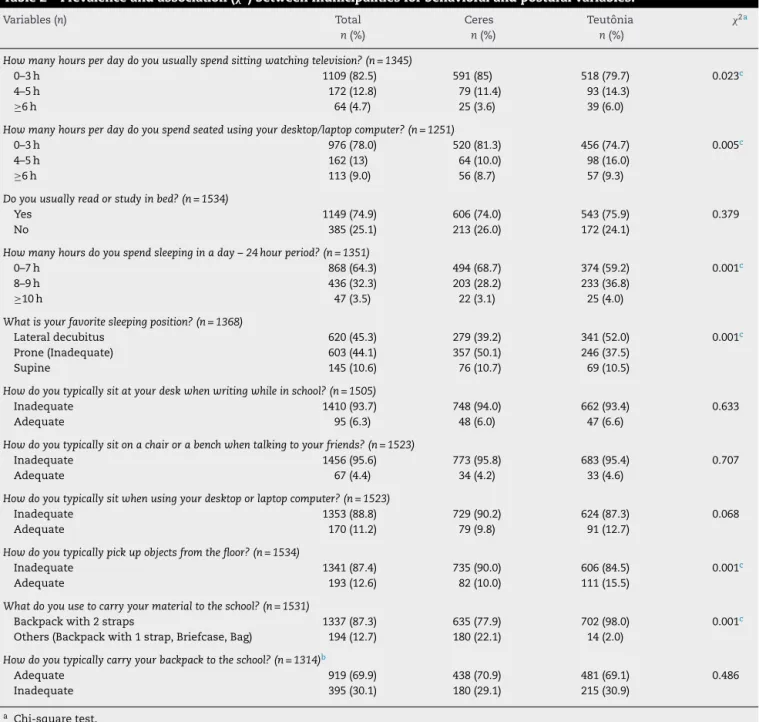w w w . r e u m a t o l o g i a . c o m . b r
REVISTA
BRASILEIRA
DE
REUMATOLOGIA
Brief
communication
Back
pain
and
behavioral
habits
of
high
school
students:
a
comparative
study
of
two
Brazil’s
regions
Dor
nas
costas
e
hábitos
comportamentais
de
estudantes
do
ensino
médio:
estudo
comparativo
de
duas
regiões
do
Brasil
Matias
Noll
a,b,∗,
Priscilla
Rayanne
e
Silva
Noll
b,c,
João
Luiz
Ribeiro
Neto
b,
Vanessa
Nunes
Leal
b,
Bruna
Nichele
da
Rosa
d,
Cláudia
Tarragô
Candotti
aaUniversidadeFederaldoRioGrandedoSul(UFRGS),EscoladeEducac¸ãoFísica(ESEF),ProgramadePós-Graduac¸ãoemCiênciasdo
MovimentoHumano,PortoAlegre,RS,Brazil
bInstitutoFederalGoiano,Ceres,GO,Brazil
cUniversidadeFederaldeGoiás(UFG),Goiânia,GO,Brazil
dUniversidadeFederaldoRioGrandedoSul(UFRGS),PortoAlegre,RS,Brazil
a
r
t
i
c
l
e
i
n
f
o
Articlehistory:
Received20October2015
Accepted12June2016
Availableonline31July2016
Introduction
Severalstudieshavedemonstratedthatbackpainisa
com-monandveryexpensiveproblemofcontemporarysocieties.1,2
Recent researchperformed by Ministry ofHealth with the
BrazilianInstituteofGeographyandStatistics3demonstrated
that27millionadultsinBrazilareaffectedbyspinedisease.
Theseresultsarestillmoreworryingbecausewealreadyknow
thereareahighprevalenceofBrazilianchildrenand
adoles-centaffectedwithbackpain4,5andposturalalterations.6,7
Recent reviews8 demonstrate that the back pain and
posturalalterationsarerelatedwithseveralfactors,as
phys-ical, behavioral,genetic and psychosocial. A recent study9
∗ Correspondingauthor.
E-mail:matiasnoll@yahoo.com.br(M.Noll).
demonstratedthatthebackpaininPolishyouthalsodepend
on place of residence. A cross-sectional population-based
studyevaluated502villageresidentsand1593cityresidents.
Theyconcludedthattheconditions oflivinginarural and
inanurban environmentinPolandpose nospecificthreat
determiningtheoccurrenceofbackpaininyouths.However,
whereasweknow,nootherstudyhasevaluateddifferences
betweendifferentplacesorregionsinasamecountry.
Furthermore, backpain research conducted inBrazilian
childrenandadolescentsisanemergingareabecauseBrazilis
acontinentalcountrywithdifferentcharacteristicsbetween
the regions(Brazilisgeopolitically dividedinto fiveregions
andeachregioniscomposedofthreeormorestates),andthe
http://dx.doi.org/10.1016/j.rbre.2016.07.014
2255-5021/©2016ElsevierEditoraLtda.ThisisanopenaccessarticleundertheCCBY-NC-NDlicense(http://creativecommons.org/
formulationanddevelopmentofpublichealthandeducation
shouldnotbebasedongeneralfeatures.Therefore,topromote
morespecificinformationaboutthistopicitisappropriateto
carryoutthis studythataimtocomparetheprevalenceof
backpainandbehavioralhabitsofstudentsabouttwoBrazil’s
cities,fromCeres,Goiásstate,andTeutônia,RioGrandedo
Sulstate.Ceres,situatedinthecenterofBrazil,thereis21,782
people,territorialareaof214,322km2andpopulationdensity
of96.69(hab/km2);andTeutônia,situatedinsouthernBrazil,
thereis29,802people, areaof178,460 km2 andpopulation
density152.68(hab/km2).10
Method
Participants
This is an epidemiological population cross-sectional and
exploratorystudyconductedinthesecondhalfof2014.The
studyincluded1546studentsfromfoursecondaryeducation
institutionsinthemunicipalityofCeres(onefederal,onestate
and two private schools);and from 5secondary education
institutionsofTeutônia(twomunicipalities,twostatesand
oneofprivateschool).Themunicipalitieswerechosen
inten-tionality.
Table1describestheparticipantsstratifiedbysexandage
tothecitiesofCeresandTeutônia.Thisstudywasapprovedby
theResearchEthicsCommitteeoftheFederalInstituteGoiano
andFederalUniversityofRioGrandedoSul,undernumber
012/2013and19832/2010,respectively,andrespectedthe
Res-olution466/12oftheNationalHealthCouncil.Thestudents
wereallowstoleavethestudyatwillandtooptoutofour
pro-cedure.Priortoparticipation,thestudents,andtheirparents
or guardians voluntarily signedan informed consent form
approvedspecificallyforthisstudy.
Instrument
Aself-administeredquestionnairetitled‘BackPainandBody
PostureEvaluationInstrument’(BackPEI)wasutilized,which
isavalidandreproduciblequestionnaire(n=260,ICC=0.937,
Agreement>70%)forBraziliansstudents,consistingofclosed
questionsandadifferentversionforeachsex.11 The
ques-tionnaireaddressedthebackpaininthelastthreemonths,
behavioralissuesandpainintensity(VAS).Formore
informa-tionseetheoriginalvalidationandreproducibilitypaper.11
Datacollectionandanalysis
Afterexplainedtheresearchaimsandobtainingagreement
fromtheDE,ameetingwasscheduledwiththedirectorofeach
schooltopresenttheresearchproject.Whenagreementwas
obtainedfromalldirectors,adatetoconducttheevaluations
was scheduledfor each school.The researcherresponsible
foradministeringthequestionnairehandedaBackPEIcopyto
eachstudentintheclassroom.Initially,theresearcher
collec-tivelyexplainedhowthequestionnaireshouldbeanswered;
afteritwasdistributed,theresearchersanswered each
stu-dent individually.11 The researcher remained in the room
during the completion of the questionnaires, which took
20mindurationonaverage,collectingthemwhenallhad
fin-ishedschool.ThesamemethodologywasusedfortheCeres
andTeutôniabythesameresearcher.
Statistical analysis was performed using the Statistical
PackageforSocialSciences(version20.0).Posturaland
behav-ioral habitswere analyzedseparatelyforeachmunicipality
using descriptive statistics.We usedthe chi-square testto
checkifhavedifferenceintheoccurrenceandfrequencyof
backpainandbehaviorhabitsbetweenmunicipalitiesCeres
andTeutônia.Wealsousedthetindependenttesttocheckif
havedifferencesintheintensityofbackpainboth
municipal-itiesforfemaleandmale(˛=0.05).
Results
Theresultsshowedhighprevalenceofinadequateposturalfor
all habitsexceptmeansoftransportofschoolsuppliesand
modeusedforthistransport(Table2).Theresultswere
posi-tivewithrespecttotimeinfrontoftelevisionandcomputer,
becausemostschoolremains0–3hadayinthesepositionsfor
bothcities.However,thefactthatonly32.3%ofthestudents
sleepthetimerecommendedintheliterature(8–9hperday)
isworrying(Table2).Itwasverifieddifferencebetweencities
ontimewatchingtelevisionandcomputerperday,hoursof
sleeppernight,preferredsleepingposition,pickupobjecton
thegroundandmeansoftransportationofschoolsupplies(X).
Theresultsalsoshowedhighprevalenceofbackpainin
thelast3months(64%),highfrequency(55.8%,onceormore
perweek)beinghigherforstudentsfromCeres(62.4%,onceor
moreperweek)comparedtoschoolofTeutônia(49%,onceor
moreperweek)(Table3).Nodifferences(p>0.05)werefound
inbackpainintensitybetweenbothmunicipalities.
Table1–DistributionofstudentsbygenderandagefromCeres/GOandTeutônia/RS.
Age(years) Ceres Teutônia
Male n(%)
Female n(%)
Total n(%)
Male n(%)
Female n(%)
Total n(%)
14 10(2.5) 6(1.4) 16(1.9) 53(15.2) 66(17.8) 119(16.6)
15 105(25.7) 146(34.8) 251(30.4) 109(31.3) 118(31.8) 227(31.6)
16 108(26.5) 127(30.3) 235(28.4) 95(27.3) 99(26.7) 194(27)
17 141(34.6) 101(24.1) 242(29.3) 60(17.2) 65(17.2) 125(17.4)
18 35(8.5) 32(7.6) 67(8.1) 23(6.6) 22(5.9) 45(6.3)
19 9(2.2) 7(1.7) 16(1.9) 08(2.3) 1(0.3) 09(1.3)
Table2–Prevalenceandassociation(2)betweenmunicipalitiesforbehavioralandposturalvariables.
Variables(n) Total
n(%)
Ceres
n(%)
Teutônia
n(%)
2a
Howmanyhoursperdaydoyouusuallyspendsittingwatchingtelevision?(n=1345)
0–3h 1109(82.5) 591(85) 518(79.7) 0.023c
4–5h 172(12.8) 79(11.4) 93(14.3)
≥6h 64(4.7) 25(3.6) 39(6.0)
Howmanyhoursperdaydoyouspendseatedusingyourdesktop/laptopcomputer?(n=1251)
0–3h 976(78.0) 520(81.3) 456(74.7) 0.005c
4–5h 162(13) 64(10.0) 98(16.0)
≥6h 113(9.0) 56(8.7) 57(9.3)
Doyouusuallyreadorstudyinbed?(n=1534)
Yes 1149(74.9) 606(74.0) 543(75.9) 0.379
No 385(25.1) 213(26.0) 172(24.1)
Howmanyhoursdoyouspendsleepinginaday–24hourperiod?(n=1351)
0–7h 868(64.3) 494(68.7) 374(59.2) 0.001c
8–9h 436(32.3) 203(28.2) 233(36.8)
≥10h 47(3.5) 22(3.1) 25(4.0)
Whatisyourfavoritesleepingposition?(n=1368)
Lateraldecubitus 620(45.3) 279(39.2) 341(52.0) 0.001c
Prone(Inadequate) 603(44.1) 357(50.1) 246(37.5)
Supine 145(10.6) 76(10.7) 69(10.5)
Howdoyoutypicallysitatyourdeskwhenwritingwhileinschool?(n=1505)
Inadequate 1410(93.7) 748(94.0) 662(93.4) 0.633
Adequate 95(6.3) 48(6.0) 47(6.6)
Howdoyoutypicallysitonachairorabenchwhentalkingtoyourfriends?(n=1523)
Inadequate 1456(95.6) 773(95.8) 683(95.4) 0.707
Adequate 67(4.4) 34(4.2) 33(4.6)
Howdoyoutypicallysitwhenusingyourdesktoporlaptopcomputer?(n=1523)
Inadequate 1353(88.8) 729(90.2) 624(87.3) 0.068
Adequate 170(11.2) 79(9.8) 91(12.7)
Howdoyoutypicallypickupobjectsfromthefloor?(n=1534)
Inadequate 1341(87.4) 735(90.0) 606(84.5) 0.001c
Adequate 193(12.6) 82(10.0) 111(15.5)
Whatdoyouusetocarryyourmaterialtotheschool?(n=1531)
Backpackwith2straps 1337(87.3) 635(77.9) 702(98.0) 0.001c
Others(Backpackwith1strap,Briefcase,Bag) 194(12.7) 180(22.1) 14(2.0)
Howdoyoutypicallycarryyourbackpacktotheschool?(n=1314)b
Adequate 919(69.9) 438(70.9) 481(69.1) 0.486
Inadequate 395(30.1) 180(29.1) 215(30.9)
a Chi-squaretest.
b Relatedonlytothoseschoolchildrentowhichvariableapplies
c Significantassociation(p<0.05).
Discussion
Thepresent study aimstocompare theprevalenceofback
painandbehavioralhabitsofstudentsabouttwoBrazil’scities,
Ceres,Goiás,andTeutônia,RioGrandedoSul.Themainresult
wastheprevalencedifferencebetweencitiesonfrequencyof
backpain, timewatching televisionandcomputer perday,
hoursofsleeppernight,preferredsleepingposition,pickup
objectonthegroundandmeansoftransportationofschool
supplies.Thissuggeststhattheregionsareaspresentspecific
conditionsandcouldberelatedwithoccurrenceofbackpain
inyouths.
Ansimilarstudy,performedinPolandbyLewandowskiand
Lukaszewska,9comparedthebackpainprevalencebetween
youthsinhabitingvillagesandcities.Differentfromourstudy,
theyconcluded thatprevalenceand characteristics ofback
pain (localization, frequency, and circumstances of
occur-rence)andthefunctionalconsequencesofbackpaininyouths
are notdependent on the place of residence. The authors
relatedtotheadvancesintechnologyusedinagricultureand
therespectivelylesserphysicalloadof‘countrychildren’.At
thesametime,manyruralareashavebecomesuburban
satel-liteswithmodernbuildingandinfrastructure,whereresidents
commutetocitiesforwork.Thesephenomenadiminish
Table3–Backpainoccurrence,frequencyinlastthreemonths,impedimentofperformingdailyactivitiesandbackpain intensity.
Variables(n) Total
n(%)
Ceres
n(%)
Teutônia
n(%)
2a
Haveyoufelt(orhavebeen)backpaininthelast3months?(n=1461)
Yes 935(64) 499(64.1) 436(63.8) 0.904
No 526(36) 279(35.9) 247(36.2)
Howoftendoyoufeel(orfelt)backpain?(n=775)b
Onlyonce 209(27.0) 75(18.8) 134(35.6) 0.001c
Onceamonth 133(17.2) 75(18.8) 58(15.4)
Onceaweek 169(21.8) 84(21.1) 85(22.6)
2to3timesaweek 178(23.0) 105(26.3) 73(19.4)
4ormoretimesaweek 86(11) 60(15) 26(7)
Doesthepainprevent(orhaveprevented)youfromperformingdailylifeactivities?(n=929)b
Yes 134(14.4) 68(13.7) 66(15.2) 0.344
No 743(80.0) 395(79.8) 348(80.2)
Idonotknow 51(5.5) 32(6.5) 19(4.7)
Total Mean(SD)
Ceres Mean(SD)
Teutônia Mean(SD)
pd
Onthescalefrom0to10,pleaseidentifytheintensityofyoubackpainforthelast3months(n=930)b
Allstudents 3.43(2.18) 3.53(2.24) 3.32(2.10) 0.149
Male 3.13(2.07) 3.28(2.12) 2.96(2.01) 0.128
Female 3.65(2.23) 3.69(2.30) 3.59(2.13) 0.591
a Chi-squaretest.
b Relatedonlytothosestudentswhichhavebackpain.
c Significantassociation(p<0.05).
dTindependenttest.
inBrazil,acontinentalcountrygeopoliticallydividedintofive
regions(approximately27timeshigherinareathanPoland),
wecould speculatedthatseveral factors maybe influence,
ashumandevelopmentindex,culturalhabits,colonization,
climate,butwecannottellexactlywhich.Morestudiesare
necessarytoelucidatethiscase.
Ourresultsareworryingforbothcitiesbecauseitwas
ver-ified a high prevalenceof backpain in the last 3months,
whichisintheheadbackpainratesdescribedinthe
litera-turethatvaryfrom20%to70%,12–16 andhighprevalenceof
inadequatebehavioralandposturalhabits.Whenpostureis
affectedbyanawkwardbodypositionwhilesittingorwhen
liftingaheavyschoolbag,themusculoskeletalsystemis
com-promised.Workstationsinschoolsmaycontributetoprevent
andperhapsreducemusculoskeletalpaininschool-aged
chil-dren.Duringclassroomlessons,childrenoftensitwithpoor
posture,havingtheirtrunk,back,andneckflexedorrotated
forlongperiod.17
Inrelationtothehighprevalenceofadequateposturewhen
carryingschoolmaterial,whichisopposedtotheprevalence
ratesforother posturalhabits, asmostschooluses rightly
the schoolbag fortransportation ofthe material(77.9% for
Ceres and 98%forTeutônia)and the same iscarried
sym-metricallyontheshoulders(70.9%and69.1%,respectively),
forthetransporttherebysignificantlyreducesthetilttorques
harmfulto the spine. Itisspeculated that this resultmay
be the effect ofpreventive programs carried out inrecent
years,specificallyforteaching thishabit,18,19 aswellasthe
strong emphasis given by the media specifically for this
position.20
Investigations asthis study are relevantas theirresults
enabledirecteducationalandpreventivework.Forexample,
in Brazil,the country withbig differences and big area,is
relevanttodevelopspecifichealthandeducationpolicies.21
Thepermanenthealtheducationisafundamentalstrategy
indailypractice,sinceitbringsperformancereflective,
pur-poseful,committedandcompetent.Thereisneed,however,to
decentralizetheteachingabilityandmakespecificprograms
foreachregionandfortherealitiesofeachtargetaudience.22
In this light,know the most harmfulhabits and acton
thecorrectionofthesameisagreatalternativetominimize
or to prevent poor habits in the school environment23,24
andthereforepreventstandardsundertakeninthisstageof
lifebecomepermanentinadulthood.21 Educationprograms
shouldbestructuredtoincludenotonlyimmediatestrategies
butallong-termtargetswithcontinuousrevaluations.
More-over, our resultsmay help, forexample,rheumatologists25
in diagnostic and treatment; and physiotherapists26
in interventions such as back schools and exercise
programs.
Ingeneral,studentsfrombothcitiespresenthigh
preva-lenceandfrequencyofbackpaininthelast3months.Our
study alsoshowdifferencesbetweencitiesonfrequencyof
back pain,time watchingtelevisionand computerper day,
hoursofsleeppernight,preferredsleepingposition,pickup
objectonthegroundandmeansoftransportationofschool
supplies. However,although the results indicate some
dif-ferences between both cities, the high prevalence of back
painandworryingposturaldataindicatesimilarpublichealth
preparationofgenericandspecificpreventionprogramsinthe
schoolforeachsituationandcity.
Conflicts
of
interest
Theauthorsdeclarenoconflictsofinterest.
Acknowledgements
We would like to thank the Coordination of
Improve-ment of Higher Education Personnel (Coordenac¸ão de
Aperfeic¸oamentodePessoaldeNívelSuperior–CAPES)and
theNational CounselofTechnologicalandScientific
Devel-opment(ConselhoNacionaldeDesenvolvimentoCientíficoe
Tecnológico–CNPq)forgrantingfunds.
r
e
f
e
r
e
n
c
e
s
1. OksuzE.Prevalence,riskfactors,andpreference-based
healthstatesoflowbackpaininaTurkishpopulation.Spine
(PhilaPa1976).2006;31:E968–72.Availablefrom:
http://www.ncbi.nlm.nih.gov/pubmed/17139213[Accessed
17.08.15][Internet].
2. LimonS,ValinskyLJ,Ben-ShalomY.Childrenatrisk:risk
factorsforlowbackpainintheelementaryschool
environment.Spine(PhilaPa1976).2004;29:697–702.Available
from:http://www.ncbi.nlm.nih.gov/pubmed/15014281
[Accessed12.10.15][Internet].
3. Brasil.IbgePesquisaNacionaldeSaúde–2013:percepc¸ãodo
estadodesaude,estilosdevidaedoenc¸ascrônicas–Brasil,
GrandesRegiõeseUnidadesdaFederac¸ão.2014.181p.
4. NollM,CandottiCT,RosaBNda,SchoenellMCW,Tiggemann
CL,LossJF.Backpainandtheposturalandbehavioralhabits
ofstudentsinthemunicipalschoolnetworkofTeutônia,Rio
GrandedoSul.JHumGrowthDev.2013:129–35.Available
from:http://www.revistas.usp.br/jhgd/article/view/61234
[Accessed17.08.15].
5. LemosATde,SantosFRdos,MoreiraRB,MachadoDT,Braga
FCC,GayaACA.Ocorrênciadedorlombarefatoresassociados
emcrianc¸aseadolescentesdeumaescolaprivadadosuldo
Brasil.CadSaúdePública.EscolaNacionaldeSaúdePública,
Fundac¸ãoOswaldoCruz.2013;29:2177–85.Availablefrom:
http://www.scielo.br/scielo.php?script=sci arttext&pid=S0102-311X2013001100005&lng=en&nrm=iso&tlng=es[Accessed 12.10.15].
6. NicheledaRosaB,NollM,SedrezJA,FurlanettoTS,Candotti
CT.Monitoringtheprevalenceofposturalchangesin
schoolchildren.JPhysTherSci.2016;28:326–31.Available
from:https://www.jstage.jst.go.jp/article/jpts/28/2/28
jpts-2015-654/article.
7. LemosATde,SantosFRdos,GayaACA.Hiperlordoselombar emcrianc¸aseadolescentesdeumaescolaprivadanoSuldo Brasil:ocorrênciaefatoresassociados.CadSaúdePública. 2012;28:781–8.
8. Calvo-Mu ˜nozI,Gómez-ConesaA,Sánchez-MecaJ.Prevalence
oflowbackpaininchildrenandadolescents:a
meta-analysis.BMCPediatr.2013;13:14.Availablefrom:
http://www.biomedcentral.com/1471-2431/13/14.
9. LewandowskiJ,ŁukaszewskaK.Characteristicsofbackpain
inPolishyouthdependingonplaceofresidence.AnnAgric
EnvironMed.2014;21:644–8.Availablefrom:
http://www.ncbi.nlm.nih.gov/pubmed/25292145[Accessed 12.10.15].
10.IBGE–InstitutoBrasileirodeGeografiaeEstatística.Pesquisa
NacionalporAmostradeDomicílios.SíntesedosIndicadores
de2009.Ibge.2010.288pp.
11.NollM,TarragôCandottiC,VieiraA,FagundesLossJ.Back painandbodypostureevaluationinstrument(BackPEI): development,contentvalidation,andreproducibility.IntJ PublicHealth.2013;58:565–72.
12.SkofferB,FoldspangÆA.Physicalactivityandlow-backpain inschoolchildren.EurSpineJ.2008:373–9.
13.TrevelyanFC,LeggSJ.Theprevalenceandcharacteristicsof backpainamongschoolchildreninNewZealand.
Ergonomics.2010;53:1455–60.
14.RivinojaAE,PaananenMV,TaimelaSP,SolovievaS,OkuloffA, ZittingP,etal.Sports,smoking,andoverweightduring adolescenceaspredictorsofsciaticainadulthood:A28-year follow-upstudyofabirthcohort.AmJEpidemiol.
2011;173:890–7.
15.NollM,deAvelarIS,LehnenGC,VieiraMF.Backpain
prevalenceanditsassociatedfactorsinBrazilianathletes
frompublichighschools:across-sectionalstudy.PLOSONE.
2016;11:e0150542.Availablefrom:http://dx.plos.org/10.
1371/journal.pone.0150542.
16.Melo-MarinsDDe,CarvalhoRGDS,GomesLE.Weightof
schoolmaterialandbackpaininstudentsleavingtheirbooks
atschool.RevDor.2015;16:276–9.Availablefrom:
http://www.gnresearch.org/doi/10.5935/1806-0013.20150056. 17.IsmailSA,TamrinSBM,BaharudinMR,NoorMAM,JuniMH, JalaludinJ,etal.Evaluationoftwoergonomicsintervention programsinreducingergonomicriskfactorsof
musculoskeletaldisorderamongschoolchildren.ResJMed Sci.2010:1–10.
18.VidalJ,BorrasPA,PonsetiFJ,CantallopsJ,OrtegaFB,PalouP. Effectsofaposturaleducationprogramonschoolbackpack habitsrelatedtolowbackpaininchildren.EurSpineJ. 2013;22:782–7.
19.BrackleyHM,StevensonJM,SelingerJC.Effectofbackpack loadplacementonpostureandspinalcurvaturein prepubescentchildren.Work.2009;32:351–60.
20.NollM,CandottiCT,VieiraA.EscoladeEducac¸ãoPostural:
revisãosistemáticadosprogramasdesenvolvidospara
escolaresnoBrasil[Internet].Movimento(ESEF/UFRGS).
2012:265–91.Availablefrom:http://seer.ufrgs.br/index.php/
Movimento/article/view/24358[Accessed12.10.15]. 21.NollM,VieiraA,DarskiC,CandottiCT.Escolasposturais
desenvolvidasnoBrasil:revisãosobreosinstrumentosde avaliac¸ão,asmetodologiasdeintervenc¸ãoeseusresultados. RevBrasReumatol.2014;54:51–8.
22.CeccimRB.Educac¸ãopermanenteemsaúde:
descentralizac¸ãoedisseminac¸ãodecapacidadepedagógica
nasaúde.CienSaudeColet.2005;10:975–86.Availablefrom:
http://www.scielosp.org/scielo.php?script=sciarttext&pid= S1413-81232005000400020&lng=pt&nrm=iso&tlng=pt
[Accessed12.10.15].
23.SteeleEJ,DawsonAP,HillerJE.School-basedinterventionsfor spinalpain:asystematicreview.Spine(PhilaPa1976). 2006;31:226–33.
24.HeymanE,DekelH.Ergonomicsforchildren:aneducational programforelementaryschool.Work.2009;32:261–5.
25.KoesBW,vanTulderM,LinC-WC,MacedoLG,McAuleyJ,
MaherC.Anupdatedoverviewofclinicalguidelinesforthe
managementofnon-specificlowbackpaininprimarycare.
EurSpineJ.2010;19:2075–94.Availablefrom:
http://www.pubmedcentral.nih.gov/articlerender.fcgi?artid= 2997201&tool=pmcentrez&rendertype=Abstract.


